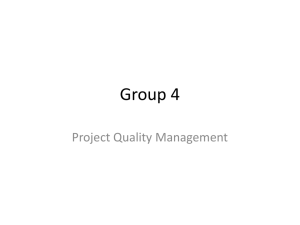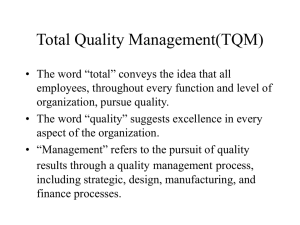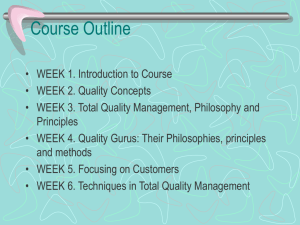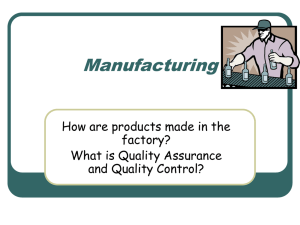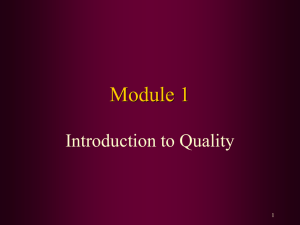What is Quality
advertisement
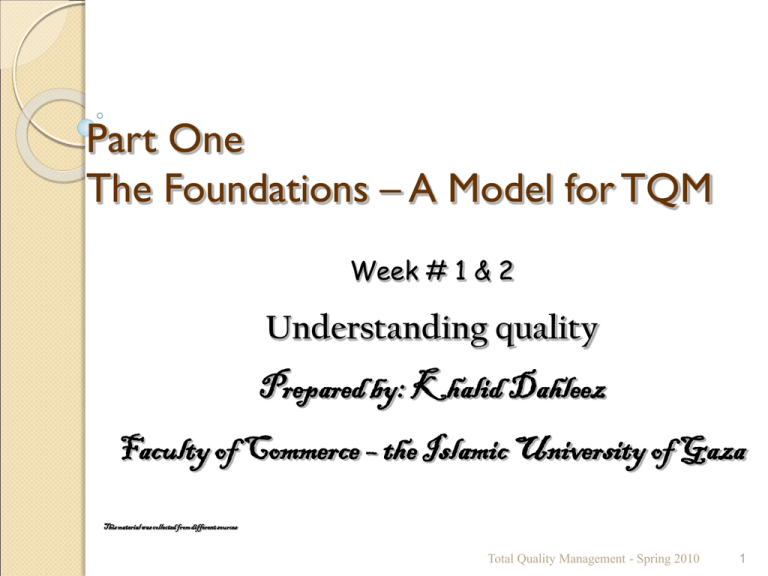
Part One The Foundations – A Model for TQM Week # 1 & 2 Understanding quality Prepared by: Khalid Dahleez Faculty of Commerce – the Islamic University of Gaza This material was collected from different sources Total Quality Management - Spring 2010 1 Be on time Focus on the issues Keep confidences Participate positively Chapter Outline 1.1 Quality and competitiveness 1.2 Understanding and building the quality chains 1.3 Managing processes 1.4 Quality starts with ‘Marketing’ 1.5 Quality in all functions Total Quality Management - Spring 2010 3 What is Quality? Total Quality Management - Spring 2010 4 1.1 Quality and competitiveness Reputation for quality, reliability, price, and delivery – all things we compete on Lessons to be learned about reputation from this story: 1. Competitive elements of quality, reliability, delivery, and price. It takes a long time to change the poor reputation for quality. Reputations, good or bad, can quickly become national reputations The management of the competitive weapons can be learned and used to turn round a poor reputation. 2. 3. 4. Total Quality Management - Spring 2010 5 1.1 Quality and competitiveness What is quality? “meeting the customer requirements” What is reliability? “It is the ability of product and service to continue to meet the customer requirements” Quality is meeting the customer requirements, and this is not restricted to the functional characteristics of the product or services. Total Quality Management - Spring 2010 6 Definition of Quality Quality is also defined as excellence in the product or service that fulfills or exceeds the expectations of the customer. There are 9 dimensions of quality that may be found in products that produce customersatisfaction. Though quality is an abstract perception, it has a quantitative measure- Q= (P / E ) , where Q=quality, P= performance(as measured by the Mfgr.), and E = expectations( of the customer). Total Quality Management - Spring 2010 7 Quality is not fine-tuning your product at the final stage of manufacturing, before packaging and shipping . Quality is in-built into the product at every stage from conceiving –specification & design stages to prototyping –testing and manufacturing stages. Total Quality Management - Spring 2010 8 What is Quality FEIGENBAUM (1983) DEFINED QUALITY AS FOLLOWS Quality is total composite product (goods and services) characteristics, through which the product in use will meet the needs and expectations of the customers. Concept of quality must start with identification of customer quality requirements and must end only when the finished product is placed into the hands of the customer who remains satisfied through various stages of relationship with the seller American Society of Quality Control (ASQC) and American National Standard Institute (ANSI) defined Quality is totality of features and characteristics of product (goods and services) that bears on its ability to satisfy given needs” Total Quality Management - Spring 2010 9 Definitions ISO 9000:2000 Quality is the degree to which a set of inherent characteristics fulfils requirements. Quantified Q=P/E P-Performance, E-Expectations Joseph M. Juran or purpose Quality is fitness for use Total Quality Management - Spring 2010 10 Definitions Philips B Crosby Quality is Conformance to requirements W. Edwards Deming A predictable degree of uniformity and dependability at low cost and suited to market Total Quality Management - Spring 2010 11 Approaches to define Quality Transcendent Approach Quality is absolute and universally recognisable. It is common notion used by laymen There is no subjective judgement and is estimated by looking at the product Product Based Approach Attributes of a particular product in a specific category These attributes are accepted as bench of quality by the industry Others in the same industry try to produce close to this quality Total Quality Management - Spring 2010 12 Approaches to define Quality User Based Approach Defined as “Fitness for use” Viewed from user’s perspective and is dependent on how well does the product meet needs of the consumer. Also known as Customer Oriented Approach Production Based Approach An outcome of engineering or operational excellence and is measured in terms of quality of conformance The producer has specifications and produces the product as per the specifications Total Quality Management - Spring 2010 13 Approaches to define Quality Value Based Approach ◦ Quality is viewed in context of price ◦ Quality is satisfactory, if it provides desired performance at an acceptable price ◦ Customer looks at the total value proposition and not the price alone Benefits Value Pr ice Total Quality Management - Spring 2010 14 Value-based Approach Manufacturing Dimensions ◦ ◦ ◦ ◦ ◦ ◦ ◦ ◦ Performance Features Reliability Conformance Durability Serviceability Aesthetics Perceived quality Service Dimensions ◦ ◦ ◦ ◦ ◦ Reliability Responsiveness Assurance Empathy Tangibles Total Quality Management - Spring 2010 15 Attributes / Dimensions of Quality Performance - main characteristics of the product/service Aesthetics - appearance, feel, smell, taste Special Features - extra characteristics Conformance - how well product/service conforms to customer’s expectations Reliability - consistency of performance Total Quality Management - Spring 2010 16 Attributes / Dimensions of Quality(Cont’d) Durability - useful life of the product/service Perceived Quality - indirect evaluation of quality (e.g. reputation) Serviceability - service after sale Total Quality Management - Spring 2010 17 Service Quality Convenience Reliability Responsiveness Time Assurance Courtesy Tangibles Total Quality Management - Spring 2010 18 Examples of Service Quality Dimension Examples 1. Convenience Was the service center conveniently located? 2. Reliability Was the problem fixed? 3. Responsiveness Were customer service personnel willing and able to answer questions? 4. Time How long did the customer wait? 5. Assurance Did the customer service personnel seem knowledgeable about the repair? 6. Courtesy Were customer service personnel and the cashier friendly and courteous? 7. Tangibles Were the facilities clean, personnel neat? Challenges with Service Quality Customer expectations often change Different customers have different expectations Each customer contact is a “moment of truth” Customer participation can affect perception of quality Fail-safing must be designed into the system Total Quality Management - Spring 2010 20 Examples of Quality Dimensions Dimension (Product) Automobile (Service) Auto Repair 1. Performance Everything works, fit & finish Ride, handling, grade of materials used Interior design, soft touch All work done, at agreed price Friendliness, courtesy, Competency, quickness Clean work/waiting area 2. Aesthetics 3. Special features Gauge/control placement Cellular phone, CD player Location, call when ready Computer diagnostics Examples of Quality Dimensions (Cont’d) Dimension (Product) Automobile (Service) Auto Repair 5. Reliability Infrequency of breakdowns Work done correctly, ready when promised 6. Durability Useful life in miles, resistance to Work holds up over rust & corrosion time 7. Perceived quality Top-rated car Award-winning service department 8. Serviceability Handling of complaints and/or requests for information Handling of complaints Evolution of Quality Management Total Quality Control Company wide Quality Control Quality Assurance Mass Inspection Quality Control (Acceptance Sampling) Total Quality Management - Spring 2010 23 Evolution of Quality Management Mass Inspection Inspecting Salvaging Sorting Grading Rectifying Rejecting Quality Control Quality Assurance Emphasis on prevention Proactive approach using SPC Advance quality planning Total Quality Control All aspects of quality of inputs Testing equipments Control on processes Quality manuals Product testing using SQC Basic quality planning Total Quality Management - Spring 2010 24 Quality Management Evolution Proactive Approach Prevention Total Quality Management 4 Stop defects at source. Zero defects Quality Assurance 3 Reactive Approach Detection 2 Quality Control Incorporates QC/QA activities into a company-wide system aimed at satisfying the customer. (involves all organizational functions) Planned and systematic actions to insure that products or services conform to company requirements Operational techniques to make inspection more efficient & to reduce the costs of quality. (example: SPC) Finding & Fixing mistakes 1 Inspection Inspect products Total Quality Management - Spring 2010 25 The Acceptance Inspection Model Process Acceptance Sampling Inspection Pass the Inspection? NO YES Acceptance Reject, Scrap, Rework, Repair Next Process Total Quality Management - Spring 2010 26 Quality Control Quality Control (QC) - “the operational techniques and activities that are used to fulfil requirements for quality”. The purpose of quality control is to uncover defects and have them corrected so that defect-free products will be produced. Quality control is limited to looking at products . Quality control is testing the final product against product quality standards. Quality control is operational techniques that are used to fulfill requirements for product quality. Total Quality Management - Spring 2010 27 Quality Control It is that part of Quality Management focused on fulfilling requirements of the Customers for the quality products. A Simplest Form of Quality Control is:Requirements Plan Do Check Conforms Yes Remedial Action No Corrective Action Product Or Service Total Quality Management - Spring 2010 28 Quality Assurance Quality Assurance (QA) - “all planned and systemic activities necessary to provide adequate confidence that a product or service will satisfy given requirements for quality”. Quality assurance is oriented toward preventing defects. It is defined by those activities that modify the development processes to prevent the introduction of defects. Quality assurance is more concerned with the processes that produce the final product, and making sure that quality is part of each phase. QA is about maturing the process towards minimum defect. It is about balancing methodology, leadership, and technology. It is about taking into account human factors as well as technological ones. Total Quality Management - Spring 2010 29 Total Quality Assurance Total Quality Assurance Total Quality Management Total Quality Management Quality Assurance Quality Assurance (Process improvement) Quality Control Quality Control (Correction of Defects) Inspection Inspection (Sorting out good from bad products) Total Quality Management - Spring 2010 The Phases of Development of Quality Assurance Systems 30 Evolution of Quality Management Company wide Quality Control Measured in all functions connected with production such as R&D Design Engineering Purchasing, Operations etc Total Quality Management Measured in all aspects of business, Top management commitment Continuous improvement Involvement & participation of employees Total Quality Management - Spring 2010 31 Evolution of Quality Management Total Quality Management - Spring 2010 32 TQM Evolution Evolution TQM Quality Control Quality Assurance Foreman Operator 1900 1918 1920 1940 1980 Total Quality Management - Spring 2010 33 What is Total Quality Management (TQM)? Total Quality Management - Spring 2010 34 TQM Total Made up of the whole Quality Degree of excellence a product or service provides Management Art of Planning, Organizing, Controlling etc. Therefore, TQM is the art of managing the whole to achieve excellence. Total Quality Management - Spring 2010 35 Meaning of TQM System TQM means Method Purpose All persons Of all divisions At every stratum MBO, Kaizen, QC Circle, 5S, TPM SQC,SPC, FMEA, MSA, OEE Q(Quality):Quality improvement C(Cost):Cost reduction D(Delivery):Delivery execution S(Safety):Safety maintenance M(Morale):Morale boosting E(Environmental):Environmental protection Total Quality Management - Spring 2010 36 Definition of TQM Systematic activities of operating the whole units of a company effectively and efficiently to supply goods and services of quality satisfactory to customers at right time and at right price, thus contributing to attaining Business Purposes. TQM is integrated organisational approach in delighting customers (both internal and external) by meeting their expectations on a continuous basis through everyone involved in the organisation, working on continuous improvement in all products, services, and processes along with proper problem solving methodology. Total Quality Management - Spring 2010 37 Definition of TQM "TQM is a management approach for an organization, centered on quality, based on the participation of all its members and aiming at long-term success through customer satisfaction, and benefits to all members of the organization and to society.” Total Quality Management (TQM) is a management strategy aimed at embedding awareness of quality in all organizational processes. Total Quality Management means that the organization's culture is defined by and supports the constant attainment of customer satisfaction through an integrated system of tools, techniques, and training. This involves the continuous improvement of organizational processes, resulting in high quality products and services. Total Quality Management - Spring 2010 38 What’s the goal of TQM? “Do the right things right the first time, every time.” Total Quality Management - Spring 2010 39 Pillars of TQM 1- Customer Focus: Studying customer needs, gathering customer requirements, and measuring and managing customer satisfaction. Customer satisfaction is seen as the company's highest priority. The company believes that it will only be successful if its customers are satisfied. 2- Process Management: Develop a production process that reduce the product variations. Applying the same process; the same product should be produces with the same level of quality every time. Teams are process-oriented, and interact with their internal customers to deliver the required results. Management's focus is on controlling the overall process, and rewarding teamwork. Total Quality Management - Spring 2010 40 Pillars of TQM 3- Employee Empowerment (Human side of Quality): TQM environment requires a committed and well-trained work force that participates fully in quality improvement activities. On-going education and training of all employees supports the drive for quality. 4- Continuous Improvement: TQM recognizes that product quality is the result of process quality. As a result, there is a focus on continuous improvement of the company's processes. This will lead to an improvement in process quality. In turn this will lead to an improvement in product quality. Measurement and analysis id the tool that has been used for that. Total Quality Management - Spring 2010 41 Pillars of TQM T. Q. M. Customer Focus Process Management Employee Training & Empowerment Continuous Improvement (through measurement and analysis) • Reduce rework activities • Shorter development cycle • Increased customer satisfaction (Cost reduction) (Cost reduction) (Quality improvement) Total Quality Management - Spring 2010 42 TQM six basic Concepts 1. Management commitment to TQM principles and methods & long term Quality plans for the Organization 2. Focus on customers – internal & external 3. Quality at all levels of the work force. 4. Continuous improvement of the production/business process. 5. Treating suppliers as partners 6. Establish performance measures for the processes. Total Quality Management - Spring 2010 43 Another way to put it At it’s simplest, TQM is all managers leading and facilitating all contributors in everyone’s two main objectives: (1) total client satisfaction through quality products and services; and (2) continuous improvements to processes, systems, people, suppliers, partners, products, and services. Total Quality Management - Spring 2010 44 Continuous Improvement versus Traditional Approach Traditional Approach Market-share focus Individuals Focus on ‘who” and “why” Short-term focus Status quo focus Product focus Innovation Fire fighting Continuous Improvement Customer focus Cross-functional teams Focus on “what” and “how” Long-term focus Continuous improvement Process improvement focus Incremental improvements Problem solving Total Quality Management - Spring 2010 45 BASIC PRINCIPLES/APPROACHES OF TQM Approach Management Led Scope Company Wide Scale Everyone is responsible for Quality Philosophy Prevention not Detection Standard Right First Time Control Cost of Quality Theme On going Improvement Total Quality Management - Spring 2010 46 Understanding and building the quality chains “A Customer’s impression of quality begins with the initial contact with the company and continues through the life of the product.” ◦ Customers look to the total package - sales, service during the sale, packaging, deliver, and service after the sale. ◦ Quality extends to how the receptionist answers the phone, how managers treat subordinates, how courteous sales and repair people are, and how the product is serviced after the sale. “All departments of the company must strive to improve the quality of their operations.” Total Quality Management - Spring 2010 47 Understanding and building the quality chains Meeting the customer requirements within the organization. Failure (QC manager and others) Failure not doing it right the first time at every stage of the process. Throughout and beyond all organizations -manufacturing & service- there is a series of quality chains of customer and supplier. Quality chains may be broken at any point, customer not satisfied. Total Quality Management - Spring 2010 48 Understanding and building the quality chains To achieve quality throughout an organization, each person in the quality chain must interrogate every interface as follows: Customers: who are my immediate customers? what are their true requirements? how can I measure my ability to meet the requirements? Suppliers: who are my immediate suppliers? what are my true requirements? Total Quality Management - Spring 2010 49 Understanding and building the quality chains The concept of internal and external customers/suppliers forms the core of total quality. Quality has to be managed – it will not just happen. Failure to meet the requirements in any part of quality chain leads to yet more failure. The price of quality is the continual examination of the requirements and our ability to meet them “continuing improvement” philosophy. Total Quality Management - Spring 2010 50 Customer types External and Internal customers External – current, prospective and lost customers Internal – Every person in a process is a customer of the previous operation.( applies to design, manufacturing, sales, supplies etc.) [Each worker should see that the quality meets expectations of the next person in the supplier-to-customer chain ] TQM is commitment to customer-focus - internal and external customers. Total Quality Management - Spring 2010 51 Customer/supplier chain Outputs to external customers Inputs from external customers Internal customers Total Quality Management - Spring 2010 52 Internal customer/Supplier relationships Questions asked by people to their internal customers What do you need from me? What do you do with my output? Are there any gaps between what you need and what you get? Good team-work and inter-Departmental harmony is required. Also the leaders role in supervising the internal customer-supplier chain. Total Quality Management - Spring 2010 53 Internal\External Customers Improvements Improvements External Suppliers Requirements Internal Suppliers Internal Suppliers External Customer Requirements Total Quality Management - Spring 2010 54 Understanding and building the quality chains Meeting the requirements the first item on the list of things to do is find out what requirements are. If we are dealing with a customer/supplier relationship, the supplier must understand not only the needs of the customer but also the ability of his own organization to meet them. Internal supplier/customer relationships are often the most difficult to manage in terms of establishing the requirements. Total Quality Management - Spring 2010 55 Customer satisfaction Customer is the Boss or ’King’ Customer dictates the market trends and direction Customer not only has needs to be supplied( basic performance functions) Also he ‘wants what he wants!’( additional features satisfy him and influence his purchase decision) Hence the Suppliers and Manufacturers have to closely follow at the heel of the customer. Total Quality Management - Spring 2010 56 Customer Satisfaction Organizational Diagram CUSTOMERS Front-line Staff Functional Department Staff Sr. Mgrs CEO Total Quality Management - Spring 2010 57 What is customer satisfaction? Is it due to Product quality? Is it due to pricing? Is it due to good customer service ? Is it due to company reputation? Is it something more? Total Quality Management - Spring 2010 58 Integrated Quality Customer Customer Requirements Selling Price Customer Schedule Quality Cost Delivery Process Capability Production Cost Process Speed Supplier Total Quality Management - Spring 2010 59 Understanding and building the quality chains To understand how quality may be built into a product or service, at any stage, it is necessary to examine the three distinct, but interrelated aspects/parameters of quality: 1. Quality of Design 2. Quality of Conformance 3. Quality of Use Total Quality Management - Spring 2010 60 Understanding and building the quality chains Quality of Design: Is the extent to which the design reflects a products or service that satisfies the customer need or expectations. TV chair example Quality of design is a measure of how well the product or service is designed to achieve the agreed requirements. The most important feature of the design, with regard to achieving quality, is the specification. Specifications must also exist at the internal supplier/customer interfaces. There must be an agreement that the operating departments can achieve that requirement. Total Quality Management - Spring 2010 61 Understanding and building the quality chains Quality of conformance to design: Is the extent to which the product or service conforms to the design standard What the customer actually receives should conform to the design. The conformance check makes sure that things go according to plan. Organizations may use the simple matrix to assess how much time spent doing the right things right. Right Things we do Right Wrong Wrong The way we do them X X ? Total Quality Management - Spring 2010 62 Understanding and building the quality chains Quality of Use Is the extent to which a product is easy to use, reliable and maintainable. Total Quality Management - Spring 2010 63 How Work Gets Done in an Organization? Inputs Delivered by suppliers Processes Steps to transform inputs Outputs customers Goods and Services valued by Quality of outputs depends on the correct execution of FIRST two steps. A mistake anywhere in the process affects everyone in one way to another. Total Quality Management - Spring 2010 64 Managing processes Have we done the job correctly? This is not quality control, it is detection. This process –detection- happens at the end of the processes. Are we capable of doing the job correctly? We should realize that an answer will only be obtained by means of satisfactory methods, materials, equipment, skills and instruction, and a satisfactory ‘process’. Total Quality Management - Spring 2010 65 Managing processes What is a process? A process is the transformation of a set of inputs, which can include actions, methods and operations, into outputs that satisfy customer needs and expectations, in the form of products, information, services or – generally- results. To produce an output meets the requirements, it is necessary to define, monitor and control the inputs to the process. Every single task throughout an organization must be viewed as a process. Total Quality Management - Spring 2010 66 Managing processes Materials S U P P L I E R S Product Procedures Methods Service Information Process People Information Skills Knowledge Training Paperwork C U S T O M E R S Equipment Total Quality Management - Spring 2010 67 Managing processes If our process is capable of meeting the requirements, “Do we continue to do the job correctly?”, this needs to monitor and control the process. Have we done the job correctly? Detection Are we capable of doing the job correctly? Do we continue to do the job correctly? Prevention Total Quality Management - Spring 2010 68 Managing processes Quality control The activities and techniques employed to achieve and maintain the quality of a product, process, or service. A set of activities designed to evaluate a developed work product. It is concerned with finding and eliminating causes of quality problem. Finding defects in specific deliverables. It is product – oriented. Focuses on employed activities and techniques. Examples (testing, monitoring, ….) Total Quality Management - Spring 2010 69 Managing processes Quality assurance The prevention of quality problems through planned and systematic activities (including documentation). A set of activities designed to ensure that the development and/or maintenance process is adequate to ensure a system will meet its objectives. Ensure that the process is defined and appropriate. Process-oriented. Aims at preventing quality problems. Examples (development of methodology & standards, establishment of QMS, …..) Total Quality Management - Spring 2010 70 Quality starts with ‘Marketing’ Marketing is responsible for determining the key characteristics that determine the suitability of the product or service in the eyes of the customer. Excellent communication between customers and suppliers is the key to total quality. Requirements must be communicated properly throughout the organization in the form of specifications which can be used as the basis for the design . Total Quality Management - Spring 2010 71 Quality starts with ‘Marketing’ The information requirements include: 1. Characteristics of performance & reliability 2. Aesthetic characteristics 3. Any obligatory regulations or standards governing the nature of the product or service Marketing must also establish systems for feedback of customer information and reaction, and these systems should be designed on a continuous monitoring. Total Quality Management - Spring 2010 72 Quality starts with ‘Marketing’ In reviewing of market readiness of a new product or service. Items that require some attention include assessment of: 1. 2. 3. 4. The suitability of the distribution & customer-service system training of personnel in the field Availability of spare parts or staff support Evidence that the organization is capable of meeting customer requirements Total Quality Management - Spring 2010 73 User purchase perceptions- from survey Performance Features Service Warranty Price Reputation ( refer pgs.72 and 73, Besterfield) Total Quality Management - Spring 2010 74 Customer satisfaction/dissatisfaction feedback Customer feedback has to be continuously sought and monitored - not one-time only!( Proactive! Complaints are a reactive method of finding out there is a problem) Customer feedback can be relayed to Mfgr. Performance comparison with competitors can be known Customers needs can be identified Relative priorities of quality can be obtained from the horses’ mouth! Areas for improvement can be noted. Total Quality Management - Spring 2010 75 Customer feedback methods Comment cards enclosed with warranty card when product is purchased. Customer survey and questionnaire Customer visits Customer focus groups Quarterly reports Toll-free phones e-mail, Internet news groups, discussion forums Employee feedback Mass customization. Total Quality Management - Spring 2010 76 Customers- Handle with care! Employers don’t pay wages but it is the customer who pays the wages! So take good care of your customers. Customer-care centers not just profitcenters! The entire organization must in effect revolve around the customer – whether the customer is being well served and if he is really pleased, contented and satisfied with the service you have to offer. Total Quality Management - Spring 2010 77 Quality in all functions For an organization to be truly effective, each part of it must work properly together. Errors have a way of multiplying. Business employs so many different specialist skills that everyone has to rely on the activities of others in doing their jobs. The commitment of all members of an organization is a requirement of ‘company-wide quality improvement’. Total Quality Management - Spring 2010 78 Effects of poor Quality 1. 2. 3. 4. 5. 6. 7. 8. 9. Low customer satisfaction Low productivity, sales & profit Low morale of workforce More re-work, material & labor costs High inspection costs Delay in shipping High repair costs Higher inventory costs Greater waste of material Total Quality Management - Spring 2010 79 Benefits of Quality 1. 2. 3. 4. 5. 6. 7. 8. 9. 10. 11. Higher customer satisfaction Reliable products/services Better efficiency of operations More productivity & profit Better morale of work force Less wastage costs Less Inspection costs Improved process More market share Spread of happiness & prosperity Better quality of life for all. Total Quality Management - Spring 2010 80 Summary Slide The following Slides are for understanding only (subject to indirect Questions): “ 26,27,28,29,36,45,54,56,57,58,59,74,75,76, 77” Other slides are required and subjects to any type of Questions Total Quality Management - Spring 2010 81

